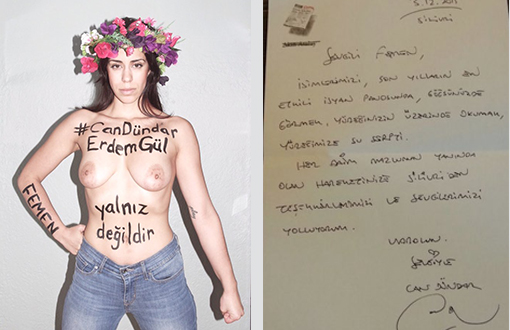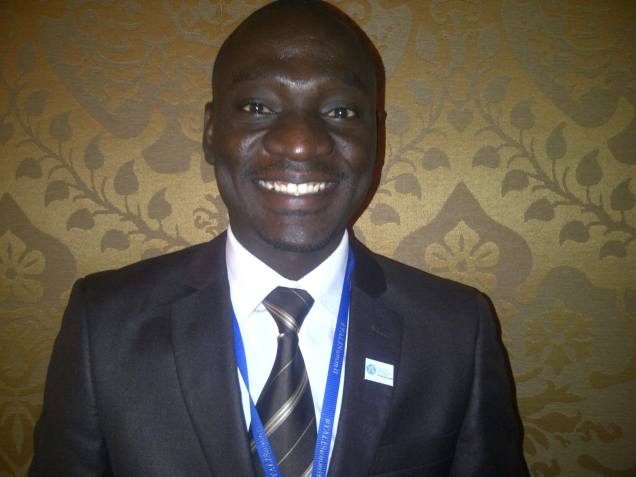America was recently faced with the unedifying spectacle of an undocumented victim of domestic abuse being arrested in a courthouse by federal agents, just minutes after being granted a protective order against an abusive ex-boyfriend. He’d threatened that if she went to the authorities he’d rat her out to immigration, and it very much looks like that’s what ended up happening.
Now more than ever, federal immigration policy is working in direct opposition to the interests of local law enforcement. According to the latest memo from the Department of Homeland Security, almost all undocumented immigrants are at risk of deportation, and many of the basic things that you need to do in order to live as an undocumented immigrant in America, like using a fake Social Security number to be able to work, make you a criminal in the eyes of the federal government. Simply being arrested is reason enough to be deported, even if you are completely innocent of any crime: no presumption of innocence here.
While some cities, like New York, are making it clear they won’t help the federal government deport immigrants, other cities are signing up to help, taking part in what’s known as the 287(g) program. Even sanctuary cities can’t prevent federal agents from going anywhere they want to, and arresting anybody they want to. Which means that the level of fear and apprehension in immigrant communities is running extremely high right now.
In turn, that means an unprecedented level of effective impunity for the perpetrators of crimes against undocumented immigrants, and even for criminal immigrants themselves. In both cases, local law enforcement needs the victims of crime to feel safe coming forward and testifying, but increasingly those victims are unwilling to do so. Art Acevedo, for instance, the police chief of Houston, told the Houston Chronicle that “when you start trying to infuse state or county or local law enforcement into the immigration debate, it tears down bridges of trust that have taken decades to build.” In fact, he says, these policies are very likely to be counterproductive, in that they make “communities less safe from crime and the prospect of a terrorist attack.”
The problem is that immigrant communities tend to underreport criminal activity at the best of times, even when they’re not facing deportation by federal authorities. Right now, rumors are flying around via text message and social media about ICE raids. Many of those rumors are false, but they’re effective all the same in driving some of the most vulnerable people in America further into the shadows, where they can suffer great harm and hardship.
There is one federal program, however, that is designed to encourage individuals to report crimes to law enforcement, without fearing removal. It’s called the U Vis .
If you’re a victim of criminal activity, and cooperate with law enforcement in terms of prosecuting the perpetrator, then you can apply for a U visa, which allows you to live and work in the U.S. legally. After three years on a U visa, you can then apply for a green card, and then, once you have a green card, you can eventually become a citizen. The U visa program has been highly successful: Some 60,000 petitions were received in fiscal 2016, and only a tiny minority of them–about 5%–were denied.
But there’s a problem: Only 10,000 U visas are allowed to be issued each year. Everybody else gets added to a constantly growing waitlist. The list, which is many years long, has more than 150,000 people on it–victims of crime, and their family members, who are stuck in legal limbo. Once you’re on the waitlist, you can apply for work authorization, but you still count as an unauthorized immigrant as far as the federal immigration authorities are concerned, and you certainly can’t travel in and out of the country.
One’s years spent on the waitlist are risky. Carolien Hardenbol, the co-director of the Immigration Intervention Project at Sanctuary for Families in New York, explains that anybody on the waitlist is always one arrest away from deportation. “The risk for U visa petitioners is, if that I get caught up in criminal activity in four years’ time, that U visa will never materialize,” she says. Even if you qualified for the visa years ago, you can always un-qualify for it before it finally gets issued.
What’s more, the latest guidance from the Department of Homeland Security explicitly rescinds any “directives, memoranda, or field guidance” that might have protected U visa petitioners from being deported. Only one class of undocumented immigrants still has explicit protection, and that’s the people with DACA status who came into the U.S. as children. People with DACA and people on the U visa waitlist both have work authorization, but the people with DACA don’t have the hope of getting a visa in the future, and the people on the waitlist don’t have the exemption from federal immigration enforcement.
There’s also the fact that U visas aren’t exactly easy to get: You can’t get a U visa by simply being a material witness to a crime. You need to show that you suffered substantial physical or mental harm, for one thing. Which means, again, that if a crime is committed in full view of multiple undocumented immigrants, the witnesses might well be reluctant to cooperate with prosecutors, who in turn will find it quite difficult to achieve a conviction.
There’s little irony in the fact that John Kelly, the new secretary of homeland security, has managed to make the homeland significantly less secure in his first few weeks on the job. Crimes are going to rise, and prosecutions are going to fall, all because of this misguided immigration crackdown. Let’s just hope that the Department of Homeland Security eventually decides to show some mercy to U visa petitioners–the people on the waiting list who don’t have their visas yet. They’ve already suffered serious harm at the hands of mostly violent criminals. They’re the last people that America should be deporting.
Month: February 2017
Shia Labeouf goes full-frontal nudity for Sigur Ros new video

Shia LaBeouf’s wang is getting some major support after it made its debut in a new music video for Sigur Ros — with the band telling TMZ, “Icelandic people are not prudish about people being naked.”
The artsy video — which features a few side profile shots of Shia’s LaPenis — went viral right after it was released on the Internet Monday morning.
Now, Georg Holm, the bassist for the band, tells TMZ, “At first I didn’t know what to make of the video, because it is so full of ideas and confusion.”
But after seeing it a few times, Georg changed his opinion … saying, “Now I love it. It seems to have no beginning and no end, and just makes you think about what might and might not be going on.”
For the record, Shia is credited with collaborating on the video concept — which, according to the director, is an artistic interpretation about the struggles of various addictions.
And now, the world has seen what Megan Fox may or may not have seen.

Orlando shooting: 50 killed, shooter pledged ISIS allegiance
ADELE – Surprise! Notoriously private Adele slips into Perth eleven days ahead before her Aussie tour kicks
She’s the world famous superstar singer as well known for a mean set of pipes as she is for keeping an incredibly tight lid on her private life.
And that’s perhaps why Adele slipped into Australia largely undetected on Saturday with her young son Angelo in tow.
Despite her down to earth vibe, the 28-year-old arrived in Perth, Western Australia in true rock star style aboard a massive jet, The Daily Telegraph reports.

She’s here: Despite her down to earth vibe, she arrived in Perth, Western Australia in true rock star style aboard a massive jet on Saturday
The Someone Like You singer was said to be smiling and in good spirits and carried her four-year-old son Angelo Konecki in her arms as she deplaned onto the tarmac.
She was dressed in a large, snuggly fluffy coat with a black outfit underneath while Angelo donned a black and white striped shirt and looked rather sleepy.
Angelo is the Grammy winner’s son with husband Simon Konecki, 42, founded of the charity Drop4Drop, who she met in 2011.
Always notoriously private, Adele only announced the pair had married by referring to her love as her ‘husband’ while collecting her Album of the Year Grammy award.

Winner: It’s been a good week for Adele as the lauded performer scored five Grammys, including best album and best song at the February 12 ceremony in Los Angeles
t’s been a good week for Adele as the lauded performer scored five Grammys, including best album and best song at the February 12 ceremony in Los Angeles.
She caused waves when she broke her Album of the Year Grammy award in half, explaining she felt Beyonce’s Lemonade should have won over her album 25.
Meanwhile, Adele revealed to Rolling Stone magazine how she got fit ahead of her tour with her trainer, Pete Geracimo.

Slim down: Adele’s diet included cutting back on sugar, giving up smoking and hitting the gym, which she hates but for weight training which has won her a toned new form
For her this meant cutting back on sugar, giving up smoking and hitting the gym, which she hates but for weight training which has won her a toned new form.
‘I’m not, like, skipping to the f*******g gym. I don’t enjoy it. I do like doing weights’, she continued.
Adele kicks off her Aussie tour at Domain Stadium in Perth on February 28 before shows in Brisbane on March 4 and 5, and Sydney on March 10 and 11.

Touring: Adele kicks off her Aussie tour at Domain Stadium in Perth on February 28 before shows in Brisbane on March 4 and 5, and Sydney on March 10 and 11
Justin Bieber Penis Vs Orlando Bloom Penis…
Reblogged on WordPress.com
FEMEN VS TRUMP – Bare-breasted FEMEN activist grabs Trump statue by crotch
 A topless activist from the feminist group FEMEN attacked a life-size wax statue of U.S. President-elect Donald Trump during an unveiling ceremony at Madrid’s wax museum on Tuesday.
A topless activist from the feminist group FEMEN attacked a life-size wax statue of U.S. President-elect Donald Trump during an unveiling ceremony at Madrid’s wax museum on Tuesday.
Reuters journalists at the scene saw the woman push past security ropes and place her hand on the statue’s crotch while screaming “grab patriarchy by the balls.”
Museum staff spent several minutes trying to restrain the woman before eventually bundling her out through a back door.
The activist group claimed responsibility for the protest on Twitter, saying: “FEMEN just grabbed Trump’s statue by the balls in Madrid.” In a recording leaked last October, Trump spoke of grabbing women “by the pussy”.
Gonzalo Presa, head of communications at the museum, called the woman’s protest “unpleasant” and said he had hoped to give a “special welcome” to Donald Trump from Madrid.
“If they want to do this they should do it directly to him. This is too easy,” he told a Reuters reporter.
Artisans had spent over three days creating the wax figure, paying special attention to the color and style of Trump´s signature hair, Presa said.
From Can Dündar to FEMEN: Our Names on Most Efficient Riot-Billboard

Arrested journalist Can Dündar has thanked FEMEN for support message with letter.
Arrested journalist Can Dündar has thanked FEMEN with a letter upon its support message sent to him and to journalist Erdem Gül who got arrested with him.
Following arrest of journalists Can Dündar and Erdem Gül, FEMEN activists had shared the photograph #CanDündarErdemGülYalnızDeğildir (CanDündarErdemGülAreNotAlone) on social media.
Can Dündar has included following expressions on his thank-you letter to FEMEN:
”Dear FEMEN; seeing our names on your breasts; the most efficient riot-billboard in recent years, and reading them on your hearts, has put our minds at ease. We send our thanks and loves from Silivri to your movement, which has always stood by the oppressed. Nice to have you. With love.”
FEMEN Turkey has shared the thank-you note Dündar has sent them with a message on social media yesterday and expressed: “These words are a honour for us”. (ÇT/DG)
Isis, Isil, IS or Daesh? One group, many names
 Image copyrightIS PROPAGANDA
Image copyrightIS PROPAGANDAThe jihadist group which controls large swathes of territory in Syria and Iraq is sometimes referred to by different names by English-speaking governments and media.
When talking about the group – which has also spawned affiliates elsewhere in the Middle East, Africa and Asia – UN and US officials generally use the acronym “Isil”, the acronym of “Islamic State in Iraq and the Levant”.
The group itself has not used that name since June 2014 when it declared the creation a caliphate and shortened its name to “Islamic State” (IS) to reflect its expansionist ambitions.
Since then, BBC News has been using that term, but qualifying it as “Islamic State group” or “self-styled Islamic State” and shortening it to “IS” on subsequent mentions.
Other media have continued to use “Isil” or “Isis”, which is based on the other widely used translations of the group’s former name – “Islamic State in Iraq and Syria” or “Islamic State in Iraq and al-Sham”.
But the term “Daesh” (or Da’ish) has also gained currency, both in the Middle East and further afield, and has been used as a way of challenging the legitimacy of the group due to the negative connotations of the word.
Daesh is essentially an Arabic acronym formed from the initial letters of the group’s previous name in Arabic – “al-Dawla al-Islamiya fil Iraq wa al-Sham”. Although it does not mean anything as a word in Arabic, it sounds unpleasant and the group’s supporters object to its use.
Daesh also sounds similar to an Arabic verb that means to tread underfoot, trample down, or crush something.
IS, Isil and Isis
The root of the Isil-Isis inconsistency lies in the Arabic word “al-Sham”.
At first, news outlets were unsure how to translate it into English, as it was not immediately clear what the group was actually referring to.
 Image copyrightIS PROPAGANDA
Image copyrightIS PROPAGANDAAl-Sham can be translated variously as “the Levant”, “Greater Syria”, “Syria” or even “Damascus”.
The term al-Sham was commonly used during the rule of the Muslim Caliphs from the 7th Century to describe the area between the Mediterranean and the Euphrates, Anatolia (in present day Turkey) and Egypt.
It was used until the first half of the 20th Century, when Britain and France drew the new borders of the Middle East and created nation states.
The term “Levant” had for centuries been used by English speakers to describe the eastern part of the Mediterranean, with its islands and the countries adjoining.
After World War One, the colonial powers understood it to be the area comprising what is now Syria, Jordan, Lebanon, Israel, the Palestinian Territories and part of south-eastern Turkey.
However, the term’s colonial association means it would be unlikely to be endorsed by the jihadists. They would also probably object to using just “Syria”, as it suggests their aspirations are limited to the modern state’s borders. Various experts have therefore said that the word al-Sham should not be translated.
Daesh
In the Arabic-speaking world, where the use of acronyms is otherwise uncommon, Daesh is used widely but with pejorative overtones.
The label has gained currency despite or perhaps as a direct consequence of the irritation it causes the group, and is now used widely across the world by politicians and in the media.
“Frankly, this evil death cult is neither a true representation of Islam, nor is it a state,” UK Prime Minister David Cameron told Parliament in December 2015 when announcing that his government would be joining France in calling the group “Daesh” rather than “Isil”.
 Image copyrightIS PROPAGANDA
Image copyrightIS PROPAGANDA
Dakota Johnson dazzles in floor-skimming sequin gown alongside hunky co-star Jamie Dornan at Fifty Shades Darker premiere in Germany-50 Nuances de Grey
Dakota Johnson cut a dazzling figure at the German premiere of Fifty Shades Darker on Tuesday night.
The 27-year-old beauty has reprised the role of Anastasia Steele in the romantic drama and posed alongside her hunky co-star Jamie Dornan, who plays Christian Grey.
Nailing her red carpet style once again as the pair continue to promote the movie all over the world, Dakota was oozing glamour in a clinging floor-length black sequin gown that featured a sexy thigh split.
The actress finished off the hot look with bright red lips and a fuss-free up ‘do.




Her hunky co-star , who held a tender arm around her waist as they posed for pictures, was looking his usual handsome self in a grey suit and thin black tie.
The pair recently admitted they’ve now formed a great friendship, which made filming their scenes together “more comfortable”.


Jamie said recently: “I was only cast five weeks before we started filming the first movie, and that’s when I met Dakota for the first time. [Now] it’s been three years, [and] Dakota and I are very close.
“We’ve got a great sort of love and respect for each other. We’re great friends and I think that makes it easier, you know? So it’s definitely more comfortable.”




Last week, Dakota revealed the film will feature a surprise tribute to her 59-year-old mum Melanie Griffith.
She explained: “There is a moment, a little surprise moment especially for my mom in this movie.”
Melanie has vowed never to watch her daughter in any of the steamy films, and so Dakota knows her actress mother is unlikely to see the tribute for herself.
But she told the Today show: “Maybe she’ll see this one specific little clip.”
And when she was asked if movie-watchers will notice the subtle tribute, Dakota said: “I hope so. I think so.”
Up Periscope: Inside Twitter’s one-year-old broadcast startup

It’s been a little more than a year since we collectively discovered our passion for personal live broadcasting on Twitter – mostly thanks to Meerkat. It’s no small irony that, today, Meerkat has pivoted away from live broadcasting while Periscope, Twitter’s own service that appeared just a few weeks after the mongoosian streaming option, survived and, by some measures thrived.
SEE ALSO: You can now live stream you GoPro footage on Periscope
It faces, though, huge questions and significant and growing competition. There is no near-term monetization plan (like any good startup, it’s focused on features) and then there’s Facebook Live. As Periscope exploded and the product name became a verb for millions of Twitter users, Facebook took notice and launched Facebook Live, first as a celeb-only tool and now as a video-streaming platform for every one of its 1.1 billion users. The company recently launched new streaming tools that make it look and feel more and more like Periscope.
IMAGE: PERISCOPE
In the meantime, Periscope continues to refine its own broadcast tools and this week added, in beta, the ability to draw on livestreams in real-time. With the Periscope sketching tool, broadcasters can doodle, in a variety of colors (there’s even a color picker/eye-drop tool), directly on the broadcast stream. It’s a feature that could come in handy for everything from breaking news to live weather event reports and sports.
The company has a lot on its plate, but maybe no one more so than company founder and CEO Kayvon Beykpour.
I met him at Twitter’s chic midtown New York offices where we sat down in one of the company café’s large wrap-around booths. I’d last seen Beykpour onstage at Re/Code’s Code conference in June of 2015. Back then he shared the stage with former Twitter CEO Dick Costolo. Obviously, the parent company has undergone big changes since then. We talked about that, Facebook Live, making money and a bunch of other hot button-topics in a wide ranging interview. Throughout, Beykpour was candid, friendly and emphatic about the future of his platform. What follows is a largely unexpurgated version of our conversation. (I have compressed my questions for clarity and trimmed back a few answers).
A year in, I want to know how it’s going?
It’s going well. It’s hard to say we could have imagined anything like what we’ve seen.
As of March 200M broadcasts, blows our mind because a couple of months prior to that it was 100M in January.
Also announced an update to a metric, one that we’ve publicly said we care the most about: Time watched
We had 41 years of live broadcast watched every day on iOS and Android. That number, as of March, is 110 years watched per day.
It’s a lot harder to succeed in this space when there isn’t cultural appetite for the type of medium that you are building.
It’s been a whirlwind, it’s been, amazing, it’s been surreal and we find ourselves continuing to go to bed and wake up every morning really excited to build the thing that we sought to create out of nothing.
Last year at SXSW we were all Meerkating.
I remember.
Was it hard to watch all that activity around Meerkat at SXSW. Did you feel like you had to hurry up with Periscope?
No. I think that’s the way the media likes to spin the story and we saw a lot of that, but in actuality, we’ve been working on Periscope for nine months at that point.
One of the nice things about starting a company like Periscope at the time that we did is that we knew from the beginning that we would not be the first. We didn’t want to be the first, we weren’t the first. There was a graveyard of other companies and active companies that did live video broadcasting even at a time when we started thinking about Periscope,
So the fact that another mobile app happened to launch at South By as we were submitting to the app store was pure coincidence and also good validation that the time was becoming ripe for the space.
It’s a lot harder to succeed in this space when there isn’t cultural appetite for the type of medium that you are building. Imagine if we had tried to launch Periscope at a cultural time when people weren’t comfortable having phones out in front of them taking pictures or shooting video for that matter,
So for us it was a sign. And we frankly thought that we were still maybe too early given technology, hardware, cell signals in different parts of the world.
So all that was a signal for us that it was the right time
I didn’t bug us that someone else was doing it because we spent nine months building something that we were confident in and we were just excited to share it with the world.
What about the benefit of being part of Twitter?
The launch pad aspect, definitely valuable. The other thing that was valuable about it and was one of the reasons we decided to make the marriage happen, was that the vision was so aligned.
I think about the purpose of Periscope in this world is to show you the world in real-time and, to me, that’s what Twitter does. It just does it through, it gives you a pulse of the world through 140 characters. It lets the voiceless have a voice. And Periscope is the same thing, but the medium is live video, rather than tweets with pictures and videos and 140 characters.
Periscope joins during former Twitter CEO Dick Costolo’s reign. What happens when Costolo leaves and Jack takes over? Was there a shift in strategy?
With respect to Periscope: Jack and Dick and a lot of the folks we came to meet throughout the process of getting to know Twitter, were always our biggest fans.
We had a number of conversations with Jack before we decided to join the company.
I think about the purpose of Periscope in this world is to show you the world in real-time and, to me, that’s what Twitter does.
While I think the transition from Dick to Jack was an important one, there was certainly no shift from a strategy perspective around how important Periscope is to the company. If anything, Jack is our biggest fan. So it was really nice to know that, as the company was embracing a new leader, that he was not only bought in, but had all of the context of how the marriage came to be.
He’s been a big believer of the product and, frankly, a big user.
You won the battle with Meerkat, but you now face a formidable component in Facebook Live. Are you worried about losing the war?
We’ve found that people on the outside like to paint war stories and that was certainly the case with other folks that were in the space before and this is a juicy one that people like to latch onto because it’s really tempting to make a David vs. Goliath story. But that’s not the way we look at it. If we spent our time worrying about competitors, we wouldn’t actually build anything of value to the world.
And that’s the mindset we had when we started Periscope and it was the thing that, in spite of the fact that many VCs we talk to, many friends we talk to, many random people we talked to said, ‘Really? You’re going to build a live-streaming app? Like A: Aren’t there a bunch of those and B: They don’t really work.
We necessarily had to be super focused on thinking about what do we want to bring into this world. Why do we care about it, why is it important and how the hell do we make that happen in the best manifestation of itself? And there is nothing different about our mindset today.
The fact that big players are dedicating a lot of time and money to catch up is flattering. It’s like recognition that this is working, that people care and that it’s a tool and a medium that people want to use. I think it’s good for the industry, ultimately, whether you define it by people who want to use the tool or by broadcaster or viewers or whatever. It’s good for there to be multiple tools out there.
We don’t spend our time worrying.
We’re worrying about the same thing we always have, which is building a product people love and I think we’re doing a pretty good job.
The new features Facebook just added feel almost Periscope like. Is it fair to say that Facebook seems to be paying attention and have interest in beating you?
Clearly they’re interested in the space. That’s not even disputable.
Listen, imitation is the sincerest form of flattery. I think we’ve built something that other people are noticing. And when I think of other people, I don’t think of other competitors. That happens, but we’re building something that people halfway around the word are taking the time to use.
Some are people that don’t even use Twitter. Some of the people don’t use the social networks that you and I frequent in the tech press. These are people like my mom. She’s not glued into tech scene, but if her son or her family or someone in Iran is random that she doesn’t know is broadcasting. I think she’s interested in seeing the world and if she has a tangible way of doing that with a tool that, for the first time, tries to reduce the idea of an interface and just focus on what’s happening.
The beauty of Twitter is that the very people who both applaud and critique Twitter, do so on Twitter.
The UI on Periscope is just what you see through the camera and the comments and the hearts float on top of that. I think that’s why the people who are engaging with our platform are often times a different audience of people [than those] who are glued to their Twitter feeds. Even though that audience is super important. It’s really important for us to have celebrities and brands like Mashable, chefs that are recognizable and politicians and protesters. All of that is really important.
Some of those people really do rely on tools like Twitter, as it is, but if you open up the map on Periscope and zoom into France and see the insane density of people who are live right now in France or in Dubai or in Saudi Arabia or in Brazil. These are people who are not necessarily using other social networking tools and I think that’s what’s interesting to us as we’re trying to create this community of people. Whether you’re passionate about the Black Lives Matter movement or you’re passionate about pottery or knitting. You can find your tribe on Periscope and you can connect with people in a way you don’t use other social networks to do, maybe with the exception of Twitter, which I think we tried to learn a lot from in terms of how organic community creation happens.
The fact that Black Lives Matter things is only a network effect thing that Twitter can truly replicate? So we try to learn a lot from that kind of organic and, often times, ephemeral community creation. Which is why you see things like the fridge meme becoming a thing on Periscope and why the Drum and Puddle Watch, which blew up in the UK, became a thing.
Twitter side of the business has become adept at monetization. Does Periscope have any sponsored content? Are there monetization plans?
There’s no direct monetization in Periscope right now, but that’s not to say that there aren’t brands creating content on Periscope and that’s also not to say that people haven’t come up with clever strategies around how to do sponsored broadcasts. There’s nothing inherent in the platform that’s incentivizing a monetization strategy. That’s because we’re not focused on that right now. Our focus is on building a product people love. There’s a lot you have to invest in doing that over time that ultimately gives you the foundation to go explore monetization.
And to your point about Twitter, Twitter now has a very disciplined engine around monetization. It took Twitter years to implement that. It took them years before they even bothered earning their first dollar, and I think that’s wise, true for any social network.
So for us, it’s what’s the right balance?
How long do we spend building our tribes, building the product that lets tribes communicate with each other?
How long do we spend building our tribes, building the product that lets tribes communicate with each other?And really for us to feel like the vision has manifested enough that we can start to now turn our focus to making Periscope more of a sustainable business from a monetization standpoint.
That time isn’t now. We don’t know exactly when that time is, but it’s something that we know if we do our jobs right in stage one, that will be a piece of cake. Because it’s much harder to build something that’s long-lasting that people actually want to use. So that’s what we’re focused on.
Are you looking at having a Periscope TV set top box?
The thing that we flirted with, which comes pretty close to that, is we have an Apple TV app. We were really interested in extending Periscope to the living room and a fantastic vehicle for us doing that was using Apple’s ecosystem in TV. For obvious reasons, we have much of the framework built. Extending it from iOS to Apple TV made a lot of sense.
Obviously, we consider ourselves fortunate to stand on the shoulders of giants and build for iOS in the first place. So taking a stab at an Apple TV app felt like a good experiment from many levels.
I think the experience of watching it on TV is great. We have this feature that allows you to explore broadcast by city.
So rather than having a map that you zoom in and out, we’ll show you a row of broadcasts from New York and Lisbon and Abu Dabi and Rio and you just jump into these broadcasts and when it finishes, it automatically takes you to next one. It’s like the first time that you can watch live TV from real people, not from a studio somewhere that’s going through a camera truck or some crazy setup. You’re seeing someone’s living room, giving a tour outside a museum, seeing somebody playing in a little league game. There’s something really authentic about that. It’s very Periscope, but just in your living room, not in the palm of your hand.
By the way, we paired that launch with our launch of landscape support because we watched all these broadcasts in portrait mode on the TV and thought, ‘Hmm.”
What about you? Do you shoot in portrait or landscape on Periscope?
I think there’s a time and a place.
When you are out in the world and you’re holding your phone, all of us, no matter how die-hard of a cinematographer fan you are, we hold our phones in portrait. They’re meant to be, made to be held [in portrait mode].
There are plenty of times where you’re showing a skyline or scenic landscape where you can afford to do [landscape] and it’s appropriate to do [it]. I’d be doing an interview with three people where I can’t fit them on the screen in portrait.
Sure, the brand recognition is super high and sure, they can throw a ton of resources behind it, but that doesn’t mean the average Joe is going to use it.
Of course, the platform should be flexible enough that if you go into landscape we don’t ruin the experience. I think Periscope is the first platform that I’ve seen that syncs phone orientation long with the viewers in real-time. Because, many other products, when you’re experiencing video, it’s either in portrait or it’s in landscape. It doesn’t change in between and there certainly isn’t this synchronicity problem where you have to sync up that orientation shift.
With Periscope, you could be watching on your iPhone, someone else could be watching her Android and our buddy could be watching on desktop or Apple TV and when I go [from portrait to landscape] at the appropriate time code, everybody’s orientation shifts. So even if you want to keep your phone in portrait, if I go to landscape, we rotate the video for you so you can keep your phone in portrait.
We wanted to think through experience to make it really pleasant. Because there is nothing I hate more than having to want to hold my phone in portrait, but the video is in landscape and I have to tilt the phone…It’s just an awful experience.
We are leading the way on a lot of product decisions, where we’ve been super thoughtful. Other companies will come along and take note of how we’ve done things and implement those features and we’ll worry about inventing the feature and other people can focus on what we did six months ago.
Have you made any big mistakes made along the way?
There’s no glaring big mistakes. All snafus we’ve had in the past, I don’t regret any one of them. As a startup, you have to go through the roller coast of running into a brick wall 80- times and learning what to do differently.
We didn’t sit in a room and invent Periscope and ship it to our beta. We built like hundreds of different permutations of what spiritually is Periscope, but mechanically was very different
We didn’t sit in a room and invent Periscope and ship it to our beta. We built like hundreds of different permutations of what spiritually is Periscope, but mechanically was very different, to the extent that the first version of Periscope wasn’t even live video, it was still photography.
You build something, you use it, you realize all the things that feel good about it and all the things that feel terrible about it and you just keep iterating. This was a year, a year of iterating and spinning out new versions every day or two and some of them we would just use ourselves, the five of us, and some we would give to our friends. If we felt really proud of it, we would send it to like 20 people.
Much of that process, pretty much until February of last year was like, ‘This isn’t right. This isn’t right. This was a mistake,’ but as with any other startup, those mistakes were just necessary.
So, no there are no glaring mistakes. If anything, I appreciate – even though those times were existential times. You’ve raised money, you’re working long hours, you don’t know if this thing is gonna work, but your gut tells you something about it, that it must exist in the world. Those are the things that got us through startup times, that’s what got us through the face of having competition around and that’s what’s gonna get us through moving forward.
We have the validation now of 200M broadcasts on this thing that a year ago didn’t exist. And we have to keep willing it into existence.
You’ve talked about the number of broadcasts, but do you know the number of users?
We certainly know them, though we only release a couple of metrics externally, we look at all kinds of metrics internally.
In August, we announced that we had 10M users. The other metric we announced in this real was that in the first 10 days, we had 1M users.
That’s not something that we plan on actively releasing externally, because we don’t think it’s the best articulation of how people are using Periscope.
We had this in August, when we released that 40 years of video watched per day number and the 10 M user number, we also announced in a pretty detailed blog post, where we talk about here’s the metric we care about and why, when we talk about time watched and 40 years per day.
We said the reason why we care about time-watched per day as a measure of success, the reason why it’s the number one metric we look at is because, it’s the best articulation of whether people are getting value out of Periscope.
I was at the White House yesterday and Michelle Obama called out Periscope as the live video app. Like, that was fucking awesome
It’s not about how many users have our app on their phone. It’s about, every day, how much time are peoples pending watching live broadcast.
It’s not even enough to say how many viewers there are because, say, 10,000 people could watch my broadcast for one second and that’s not particularly interesting. That’s not a good broadcast. But if we’re looking at the number of people watching and how long they’re watching, we aggregate that together? Now that’s an interesting metric. That’s what we call “time watched.”
We announced time-watched, but we understand that there’s this narrative, this mindset where people are obsessed and infatuated with MAUs and DAUs. So we wanted to come out in front in August and say, ‘Listen, here are our numbers. We’ve got 10M total users. We showed a graph of our DAUs, which is even more fine-grained detail than people normally show, and all of them were hockey stick. We said, ‘This is not a metric we’re gonna show you guys anymore. Here’s why we care about this metric.’
I think we felt good about that, because we wanted to be transparent with, not necessarily the media, but we wanted the users to know that we are measuring ourselves in a way that’s aligned with their interests. Because, ultimately, what broadcasters care about is, what Mashable cares about, when you go live, you want to know that people are watching. They care about actual time watched.
It’s important, organizationally, for us to align ourselves sin the same way. That way, we’re building our features that drive that number. We’re not building growth hacks that drive number of views up or number of users.
We’re not building growth hacks that drive number of views up or number of users.
We could go spend tons of money on App Store download and drive our total downloads up a ton, but it’s not going to do anything for our users.
So that’s kind of how, philosophically, we looked at it.
At some point, you will have to switch, right to monetizing, but if you can’t give people the number of eyeballs, how are you going to do that? You can’t say we’re never giving you that number again because it’s not important.
I think it’s important to understand that you cannot grow a metric like time watched without growing substantially your user base. You just can’t. If you looked at all our use numbers, they’d be hockey sticks, as well, but it’s not the right metric to look at. Because an advertiser doesn’t care that 10,000 people opened a live video broadcast that was seven minutes and watched for a second.
If they did, they’re caring about the wrong things.
I think what people care about is are people engaging in this content. So I think the right measure is something that includes viewership, but also the length of that viewership. Some people obfuscate that because it’s in their interest to obfuscate that. On Periscope, you can see the number of viewers you have, but were focusing on time watched as the more important measure.
Ultimately, if you’re a broadcaster, you wanna know that people watched it or not and that’s not just about the views.
Ultimately, if you’re a broadcaster, you wanna know that people watched it or not and that’s not just about the views.You know, updating numbers externally, there are different use cases for that. Some of that is intrigue, some of that is, people trying to generally ascertain value based on how many users are using a platform. Which is why we have released the number and we’re not saying we’ll never release it again. We are aligning our interests and for us that means this metric is important and here’s why, and were being super-transparent about it.
How does the conversation going on around Twitter affect Periscope?
How do I answer this question? I’ll start by saying I think — and you can appreciate this given the world that you live in — but I think that the drama that you hear about Twitter is exacerbated by the media, quite a bit. The beauty of Twitter is that the very people who both applaud and critique Twitter, do so on Twitter. And there’s something beautiful about that. But I also think that that does lead to an echo chamber sometimes where there is more drama externally than there is internally
That being said, to hone in on your question. One of the things I love about the relationship with Twitter is that we’re very much like a startup with the resources of Twitter behind us. I’ve never, ever felt pressured by Twitter Inc., to do anything differently than spiritually how Periscope would want to do it. Whether that’s how we talk about something, what we build, how fast we build, how fast we monetize. Insert how many other of those questions you want.
The beautiful thing about Twitter — part of this is because they’ve been around and they’ve done this with other companies. They’ve acquired other companies like Vine. They understand to really succeed with a merger like that you have to give autonomy to a startup that must operate like startup.
The processes and decision-making frameworks that a multi-billion-dollar 4,000-person company has is necessarily different than the processes and methodologies that a 30-person startup (or 5-person startup at the time) would have.
So we are one big, happy family, all under the same umbrella, but I think, operationally, I really respect the autonomy Twitter has given us.
So we are one big, happy family, all under the same umbrella, but I think, operationally, I really respect the autonomy Twitter has given us.
And it’s this amazing thing, kind of like best of both worlds scenario where we get to be a startup, but we can raise our hands and ask for support in all the ways we need that aren’t our core competencies, whether it’s leveraging the amazing comms team where we can reach out to the amazing relationships that Twitter already has with folks like you. Or whether is leveraging the media team that’s spread around the world in different verticals like news, sports and music. Whether it’s leveraging the legal and policy teams that lets us navigate very complex waters and countries where services like Twitter and Periscope are often in questions. That would have been impossible for us to do all of that as well as we can do today as a startup.
So that’s that’s the sort of perfect balance we like to strike. And that’s the kind of cohesion we see every day,
Could you envision a day where Periscope becomes a button, “Go Live,” in Twitter
Totally. I think people should be able to… the process of being able to start a live video broadcast or watch a live video broadcast should be simple and frictionless.
You’ve already seen us take strides towards that with the integration of Twitter on the viewership side.
If I were to go live, and you’ve; probably saw this on your Twitter feed with all The Daily Show broadcasts [Beykpour had just come back from doing a bunch of Periscopes on the set of that show] you see a tweet in your timeline now and it’s not a link, it’s just auto-playing video.
Before, when we launched, if you were to syndicate your Periscope broadcast in Twitter, it was just a link. You’d have to go, you’d have to download the app, you couldn’t watch it. The user in Germany who stumbles into a tweet that’s Periscope and has never heard of Periscope, shouldn’t have to go and download an app. They should just get their content. We’ve already implemented that from the viewership side.
We’ll be exploring that kind of integration and all kinds of other ways for viewers for broadcasters. We’re not dogmatic about that. We want it to be frictionless to watch or create video.
Are you anxious to let me people know about the existence of Periscope. Especially when you think about the befit Facebook Live gets from being a part of the super-well-known Facebook brand?
There are actually pros and cons of having brand awareness of product experience so ingrained.
If you have a product that’s been around for a decade, people associate the mechanics of that brand with what it did when they first heard about it, and it’s really difficult for them to change their minds on what they would use that thing for and what they wouldn’t use that thing for.
Companies, through and through, have struggled with this, even outside the realm of social networking, doing something orthogonal to what they were doing before or even to add a new capability, however cool it might be, people will use that product to do one thing because that’s how they started using it 5 years ago, 10 years ago.
Sure, the brand recognition is super high and sure, they can throw a ton of resources behind it, but that doesn’t mean the average Joe is going to use it.
Other way of looking at it is, Periscope as a brand is incredibly nascent compared to Twitter, but the beauty of our marriage is that we don’t have to be, the Periscope brand doesn’t have to be the only brand that paves the way for live video consumption and all the other things we care about like giving our live broadcasters a great experience, more reach, a better time watched. Because all of integration… Everyone knows Twitter.
I remember seeing a study that had the most well-known brands in the World. Twitter was right up there with Coca Cola….So we get we get to piggyback on that.
That allows us to carve out this best of both worlds scenario where we’re leveraging the pervasiveness of the Twitter brand, bit we’ve got our own thing going with Periscope.
I was at the White House yesterday and Michelle Obama called out Periscope as the live video app. Like, that was fucking awesome
The nice thing about being a nascent brand is that we’re associated with one thing: watching live video and creating live video and that gives us a tremendous amount of flexibility. The most important part of that flexibility? Every day people use it.





